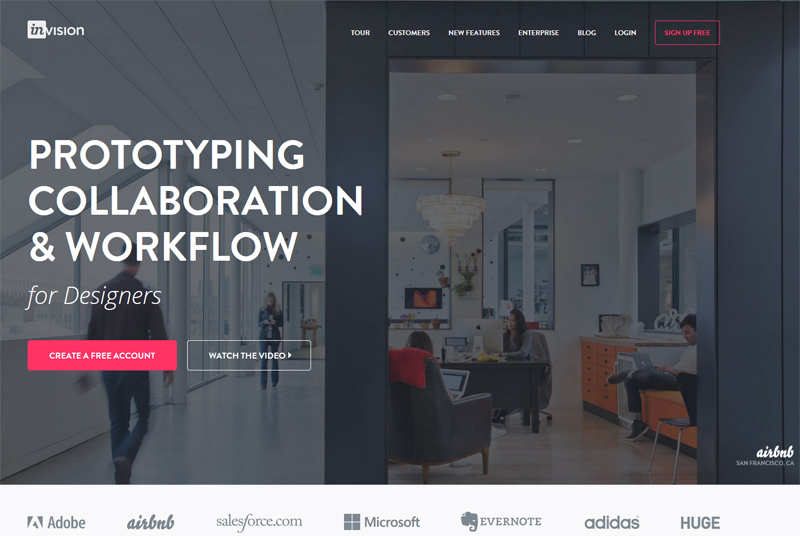What UI design tools do you use in your work? Why did you choose them? What do you appreciate in UI design tools the most? Would you like to know what software other designers prefer and why? Being loyal to one and the same product is great, but this doesn’t work well with the software. If you want to be up-to-date you can’t use obsolete tools. What’s more, there is always a possibility that you don’t know about more user-friendly, simple and convenient software available on the market. Today you will have a wonderful possibility to overview top UI design tools, distinguished by the developers’ community.
Can you guess what the first one in the list is? A pen and a paper! Yes, your eyes don’t deceit you! A pen and a whiteboard are quicker and easier than any software package for collaborative wireframing. In case you are decent with pen and paper, use them for quick sketching of low fidelity mockups.
Are you ready to move further?
1. Invison
The software brings your designs to life with interactive prototypes, allows real-time design presentation & collaboration as well as seamless design communication and easy design projects management.
2. Lucidchart
Lucidchart is the right way to go. There are shape libraries for website, android, and iOS mockups (iPhone and iPad). Besides, it’s really easy to create interactions so that you can get a feel for the whole flow and process. Designers also like the real-time collaboration aspect of Lucidchart because they can work together and get quick feedback from other people they partner with. Click the links below to find out some additional information about it.
3. Fireworks
Designers find Fireworks from Adobe much faster than Photoshop or Illustrator. The tool is great for everything from rough wireframe sketches all the way through polished, high-fidelity mockups. It’s, probably, the most popular mockup tool at Google (followed by OmniGraffle). You get access to the collection of common UI widgets (radio buttons, text areas, etc.) that are easy to drop in. Fireworks was built for screen design (no fuzzy lines), but its UI is junky and unstable.
4. BalsamIQ
Many designers use BalsamIQ and absolutely like it. There are some limitations, but the company is constantly improving the product. You may want to have a look at their GetSatisfaction page to get a better idea of limitations and improvements that are on the way. One of the reasons why some users avoid BalsamIQ is its sketchy look. This might not be something you would like to give out to a customer. We believe it also depends on how (or if) you are going to work afterwards with the same data.
There are lots of other tools out there, so it’s possible that there are much better alternatives that suit your particular needs. Here are some other options to check out:
5. Napkee
Napkee will let you export Balsamiq Mockups to Twitter Bootstrap at one click of a button. Find out more about its best features, keeping in mind that the software is 100% free.
6. Mockingbird
The software is ridiculously easy to use and makes prototyping completely effortless. You can have your mock-up done in a day. The drawback is that its functionality is pretty basic. Mockingbird eliminates the time needed to learn something new though and that’s why many developers choose it.
7. Also check out this interesting idea of using Google Docs:
8. Creately
Some developers highly recommend Creatly, with its modern interface and collaboration, so you can work with your peers and clients. The software also has iPhone and iPad mockup tools.
Advanced developers use a number of tools depending on the complexity and concrete nature of the product concept. Here are the ones that passed lots of tests and evaluations and were recognized as the best in the industry.
Great for sketching ideas:
9. UI Stencils
UI Stencils is a toolkit to help design websites and applications. They are crafted and designed with care and made from durable materials. UI Stencils allow you to quickly generate ideas with a simple, yet comprehensive set of icons and symbols. The company releases new versions frequently to stay current with changes in OS and components.
Using a pencil and paper is often the best way to get ideas down. Revolutionary products have been conceived on a napkin before taking shape digitally. Their stencil kits pays homage to the fact that ideas flow naturally with pencil and paper. The kits are designed to quickly sketch user interface, user flows, and ideas for how your app might work. – See more at: http://www.uistencils.com/pages/about#sthash.Z4sKLPcz.dpuf
Good for low fidelity:
10. Axure
Here’s what designers like in Axure:
– Masters can be placed in different positions on different pages, and may contain interactions.
– Wireframes can be as visually designed as you want them to be.
– Both prototypes and specifications can be generated from a single document.
– Prototypes may contain animations, touch gestures, etc.
– Axure is available on both Mac and PC.
– Sketchiness, greyscale, and handwritten fonts can be turned on & off globally depending on your needs.
– Version control may be used for teams to collaborate in documents.
– Secure online sharing of prototypes is readily available.
– Built-in annotations offer customizable fields – so you may show certain fields to a business stakeholder and another to development teams without having to recreate the file.
– You may choose the pages to export with each release without deleting or reordering.
– There’s a big online community and the product managers are responsive.
– Extensive widget libraries are available, and many of them include realistic interactions (not just flat screens.)
– It’s easy to learn.
– Lots of drag and drop.
– It’s very modular. You build components like headers once and then reuse them.
– You can develop very realistic prototypes quickly.
– It’s low cost.
11. Sketch
If you want one tool for the entire design process: diagramming, illustration, wireframes, and pixel-perfect mock ups, try Sketch. It gets the job done better than anyone else in many developers’ opinion. Here’s why they love it:
Tools for feedback and usability testing:
12. Notable, Solidify, Verify
Try out ZURB products and you’ll find them really awesome. ZURB Apps help you quickly design great products through rapid prototyping, iteration and user feedback.
13. OmniGraffle
Take a look at OmniGraffle, but, please note, that it’s only for a Mac and iPad.
14. HotGloo
This is another interesting app you might want to check out, and they’re web-based.
15. WireframeSketcher
Take a look at WireframeSketcher wireframing tool. It’s an offline desktop tool that comes with fast and native UI and is available on Mac, Windows and Linux. Unlike the web tools, WireframeSketcher really puts you in control of your projects, files and assets. It also offers all the advanced features that are expected from it: masters, clean and sketchy themes, annotations, online sharing, and widget libraries.
Here are two more relatively inexpensive mock-up tools tested by the community. They have a free trial period, so you don’t take any risk.
16. Mockflow
Collaborate user interface concepts for your apps and websites with super-easy wireframing design.
17. Jumpchart
Every project is easier once you have a plan. With Jumpchart content, mockups, attachments, architecture and notes will be in one place to simplify your work.
18. Keynote + Keynotopia
Keynote for iOS makes it simple to create and deliver beautiful presentations with nothing but your fingers. Powerful tools and dazzling effects bring your ideas to life. You can work seamlessly between Mac and iOS devices. And work effortlessly with people who use Microsoft PowerPoint.
Keynotopia transforms Keynote and PowerPoint into the best rapid prototyping tools for creating mobile, web and desktop app mockups.
19. Qt and QML
Qt and QML are not simply design tools, but a full development suite. Developers like using them to quickly develop interactive prototypes.
20. Blueprint
Blueprint is an iPad app specified for creating hi-fi mockups of iPad apps. It comes with most iOS elements and very smooth transitions.
There’s a free version to try out too:
21. Illustrator
Illustrator is complete feature set, but it’s bloated (slow to load) and requires a lot of fuss if you want perfectly sharp lines and edges.
22. InDesign
InDesign has a table component that is unmatched if you create complex tables and ever need to resize a column. It also makes it possible to drop images inline with text. Unfortunately, InDesign also suffers from the same problem of fuzzy lines and edges as Illustrator.
23. Easel
Easel is a cool tool to take on UI mockup using common frameworks like bootstrap.
24. POP
POP is a prototyping on paper | iPhone app prototyping tool which lets you make your designs on paper easier. Create wireframes on your favorite notebook, take your time and sketch your interface carefully. Pen & paper are the best tools. Complicated software only gets in the way.
25. SwordSoft Layout
If you want to use an offline tool, you can download SwordSoft Layout – a great one for creating web designs and software mockups.
26. Kettic
We advise you to discover Kettic, which may turn out to be quite useful in designing UI. Its built-in UI controls offer you many kinds of choices to create your desired mockups.
27. Mockup Everything
Mockup Everything is a realistic mockup software for designers. This is the best place to go before going to print. Mockup your designs here on a variety of templates (hundreds of options available) to make sure they’re just right before you present options to your clients.
28. App Cooker
And to end up our list, go and have a look at the App Cooker. It is another crazy iOS oriented tool. It allows making a mockup on the go, in less than an hour, together with your client. It is the ultimate all in one to start an App.
Conclusion
This was the ultimate list of the most popular UI design tools, based on developers’ choice and explanations. We sincerely hope that you’ll find it useful and maybe even discover absolutely new awesome software never used before. If we missed something in our entry, please, feel free to insert your additions into the comments section. If you have experience of working with some of the above mentioned tools, please, share it with the community.
All of us understand that the choice of software depends on the purpose and the result you want to get. Are you drawing a mockup to try to explore different solutions to a problem? Are you making something that you can show to stakeholders/clients to get feedback/signoff? Are you making something that you can show to developers so they will know what to build? Are you making something to put in front of the users to see if they can understand what it is and how to handle it?
We believe that at the early stages a pencil and a paper or a whiteboard are the best tools for exploration. But as you move further, you need more complicated prototyping tools, like the ones referred to in our blog post or even HTML, CSS, and Javascript markup languages if you are building a website or app.
The choice is up to you. Though, supposing with every reason that we have offered you many good options for creativity expression.
About the Author
Helga Moreno is a learning junkie, requiring a new dose of fresh information every day. She is always keeping her notepad at hand in order not to miss a single thrilling event happening in cyberspace. She diligently puts down all her thoughts in order to share the most interesting of them with web community in general and TemplateMonster’s readers in particular. Want to know more about her? Visit her Google+ profile.









































